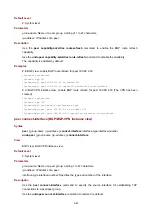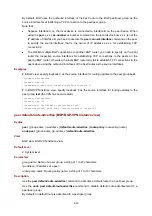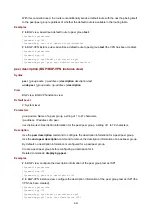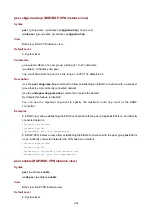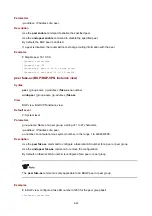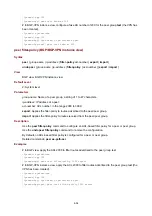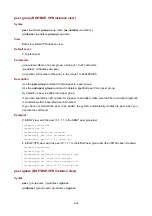
6-40
z
The network route to be injected must exist in the local IP routing table, and using a routing policy
makes route management more flexible.
z
The ORIGIN attribute of the network route injected with the
network
command is IGP.
Examples
# In BGP view, inject the network segment 10.0.0.0/16.
<Sysname> system-view
[Sysname] bgp 100
[Sysname-bgp] network 10.0.0.0 255.255.0.0
# In BGP-VPN instance view, advertise the network segment 10.0.0.0/16 (the VPN has been created).
<Sysname> system-view
[Sysname] bgp 100
[Sysname-bgp] ipv4-family vpn-instance vpn1
[Sysname-bgp-vpn1] network 10.0.0.0 255.255.0.0
network short-cut (BGP/BGP-VPN instance view)
Syntax
network
ip-address
[
mask
|
mask-length
]
short-cut
undo network ip-address
[
mask | mask-length
]
short-cut
View
BGP view, BGP-VPN instance view
Default Level
2: System level
Parameters
ip-address
: Destination IP address.
mask
: Mask of the network address, in dotted decimal notation.
mask-length
: Mask length, in the range 0 to 32.
Description
Use the
network short-cut
command to configure an eBGP route as a shortcut route.
Use the
undo network short-cut
command to restore the default.
By default, a received eBGP route has a priority of 255.
The
network short-cut
command allows you configure an eBGP route as a shortcut route that has
the same priority as a local route and thus has greater likehood to become the optimal route.
Examples
# In BGP view, configure route 10.0.0.0/16 as a shortcut route.
<Sysname> system-view
[Sysname] bgp 100
[Sysname-bgp] network 10.0.0.0 255.255.0.0 short-cut
# In BGP-VPN instance view, configure route 10.0.0.0/16 as a shortcut route. (the VPN has been
created).
<Sysname> system-view
[Sysname] bgp 100
























